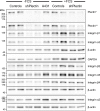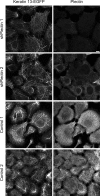Effects of Plectin Depletion on Keratin Network Dynamics and Organization
- PMID: 27007410
- PMCID: PMC4805305
- DOI: 10.1371/journal.pone.0149106
Effects of Plectin Depletion on Keratin Network Dynamics and Organization
Abstract
The keratin intermediate filament cytoskeleton protects epithelial cells against various types of stress and is involved in fundamental cellular processes such as signaling, differentiation and organelle trafficking. These functions rely on the cell type-specific arrangement and plasticity of the keratin system. It has been suggested that these properties are regulated by a complex cycle of assembly and disassembly. The exact mechanisms responsible for the underlying molecular processes, however, have not been clarified. Accumulating evidence implicates the cytolinker plectin in various aspects of the keratin cycle, i.e., by acting as a stabilizing anchor at hemidesmosomal adhesion sites and the nucleus, by affecting keratin bundling and branching and by linkage of keratins to actin filament and microtubule dynamics. In the present study we tested these hypotheses. To this end, plectin was downregulated by shRNA in vulvar carcinoma-derived A431 cells. As expected, integrin β4- and BPAG-1-positive hemidesmosomal structures were strongly reduced and cytosolic actin stress fibers were increased. In addition, integrins α3 and β1 were reduced. The experiments furthermore showed that loss of plectin led to a reduction in keratin filament branch length but did not alter overall mechanical properties as assessed by indentation analyses using atomic force microscopy and by displacement analyses of cytoplasmic superparamagnetic beads using magnetic tweezers. An increase in keratin movement was observed in plectin-depleted cells as was the case in control cells lacking hemidesmosome-like structures. Yet, keratin turnover was not significantly affected. We conclude that plectin alone is not needed for keratin assembly and disassembly and that other mechanisms exist to guarantee proper keratin cycling under steady state conditions in cultured single cells.
Conflict of interest statement
Figures






Similar articles
-
The molecular architecture of hemidesmosomes, as revealed with super-resolution microscopy.J Cell Sci. 2015 Oct 15;128(20):3714-9. doi: 10.1242/jcs.171892. Epub 2015 Sep 1. J Cell Sci. 2015. PMID: 26330528
-
Specificity of binding of the plectin actin-binding domain to beta4 integrin.Mol Biol Cell. 2003 Oct;14(10):4039-50. doi: 10.1091/mbc.e03-05-0268. Epub 2003 Jul 11. Mol Biol Cell. 2003. PMID: 14517317 Free PMC article.
-
Role of binding of plectin to the integrin beta4 subunit in the assembly of hemidesmosomes.Mol Biol Cell. 2004 Mar;15(3):1211-23. doi: 10.1091/mbc.e03-09-0697. Epub 2003 Dec 10. Mol Biol Cell. 2004. PMID: 14668477 Free PMC article.
-
Keratin intermediate filaments: intermediaries of epithelial cell migration.Essays Biochem. 2019 Oct 31;63(5):521-533. doi: 10.1042/EBC20190017. Essays Biochem. 2019. PMID: 31652439 Review.
-
Plectin: a cytolinker by design.Biol Chem. 1999 Feb;380(2):151-8. doi: 10.1515/BC.1999.023. Biol Chem. 1999. PMID: 10195422 Review.
Cited by
-
Plectin-mediated cytoskeletal crosstalk controls cell tension and cohesion in epithelial sheets.J Cell Biol. 2022 Feb 9;221(3):e202105146. doi: 10.1083/jcb.202105146. Epub 2022 Feb 9. J Cell Biol. 2022. PMID: 35139142 Free PMC article.
-
The Cohesive Metastasis Phenotype in Human Prostate Cancer.Biochim Biophys Acta. 2016 Dec;1866(2):221-231. doi: 10.1016/j.bbcan.2016.09.005. Epub 2016 Sep 24. Biochim Biophys Acta. 2016. PMID: 27678419 Free PMC article. Review.
-
[Plectin Promotes the Migration of Hepatocellular Carcinoma Cells Through Inducing F-actin Polymerization].Sichuan Da Xue Xue Bao Yi Xue Ban. 2024 Jan 20;55(1):60-66. doi: 10.12182/20240160106. Sichuan Da Xue Xue Bao Yi Xue Ban. 2024. PMID: 38322534 Free PMC article. Chinese.
-
Cytoskeletal control of early mammalian development.Nat Rev Mol Cell Biol. 2021 Aug;22(8):548-562. doi: 10.1038/s41580-021-00363-9. Epub 2021 Apr 29. Nat Rev Mol Cell Biol. 2021. PMID: 33927361 Review.
-
Plectin: Dual Participation in Tumor Progression.Biomolecules. 2024 Aug 24;14(9):1050. doi: 10.3390/biom14091050. Biomolecules. 2024. PMID: 39334817 Free PMC article. Review.
References
Publication types
MeSH terms
Substances
LinkOut - more resources
Full Text Sources
Other Literature Sources
Research Materials

